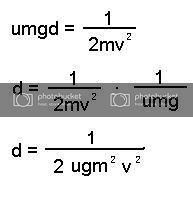tris-
Failed Geordie and Parmothief
- Joined
- Jan 2, 2004
- Messages
- 15,260
afaik the stopping distance of a vehicle should increase with mass of the car.
i.e. a car of 1500kg should take longer to stop than a car of 1000kg.
problem is, on paper the mass seems to make no difference.
using the formula
umgd = 1/2mv^2
(u = friction coefficient)
d = 1/2mv^2 / umg
d = 1/2v^2 / ug
which shows mass will cancel out. except using only those formulas im supposed to show increasing mass will make a difference . is it even possible?
. is it even possible?
i.e. a car of 1500kg should take longer to stop than a car of 1000kg.
problem is, on paper the mass seems to make no difference.
using the formula
umgd = 1/2mv^2
(u = friction coefficient)
d = 1/2mv^2 / umg
d = 1/2v^2 / ug
which shows mass will cancel out. except using only those formulas im supposed to show increasing mass will make a difference
 . is it even possible?
. is it even possible?
